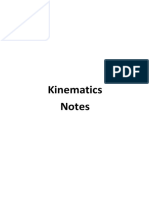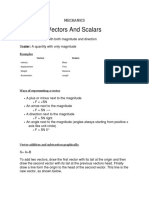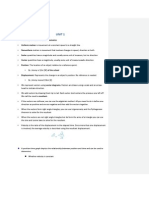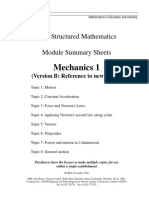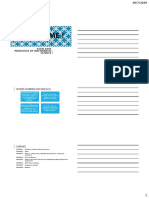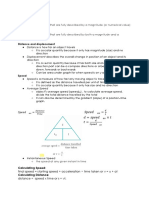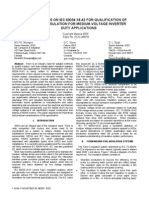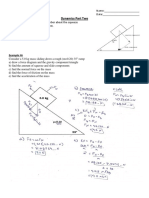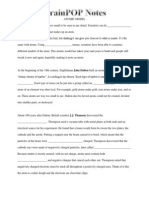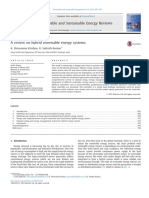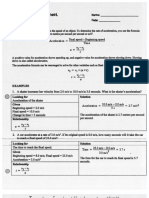Edexcel IAL M1 (2018) Knowledge
Modelling
Mechanics is about objects moving (and sometimes stationary)
Objects that can move:
Particle A point mass – it has no dimensions
Rod A (length) mass – it has no thickness,
Its mass is even distributed along its length which means its mass acts at its centre
point
Lamina A(n area) mass – it has no thickness
Its mass is even distributed across its area which means the mass will act at its ‘centre
point’ most likely calculated by considering its two dimensions (at right angles) to one
another.
Uniform body A (volume) mass
Its mass is evenly distributed through its volume.
We assume that a rod, lamina or uniform body do not bend or distort
Bead Used with a wire or a string, it moves freely along the wire or string
Things that restrict movement:
Surfaces – can be horizontal, vertical or inclined at an angle
Inclined surfaces Either the angle is given as an angle e.g. 30°, q, or a trigonometric ratio e.g. sin $
%
Smooth surface The surface is so smooth there is no friction
Rough surface The surface is rough meaning friction is uniform across its surface
Objects can be connected restricting their movement
Inextensible/ It has no thickness
inelastic string It does not stretch (change its length)
When under tension it has an influence when not under tension it has no influence
Smooth and light Used with a string
pulley It has no friction and no mass
Wire It has no thickness
Peg It has no dimensions, so it acts at a point.
It can suspend or support an object
External influences
Gravity (g) Gravity is modelled as 9.8m/s2
It always acts vertically (even on an inclined plane, so at an angle to the plane)
All calculations with gravity should be rounded to 2 significant figures of accuracy in
the final answer (not before).
Wind / Air Wind/air resistance are modelled as zero, unless specifically identified in a question
resistance as being different
�Kinematics – particles moving in a straight line
‘SUVAT’ equations, the units are important, calculations may only be made using the specified units.
‘SUVAT’ measurements: all units are vectors so have a direction
s = displacement (m) u = intial velocity (m/s or ms-1) v = final velocity (m/s or ms-1)
a = acceleration (m/s2 or ms-2) t = time (s)
n.b. deceleration is an acceleration with a negative value
Scalar (non vector) measurements:
distance = |s| speed = |v|
n.b. be careful of changes in direction as the distance/speed could be changed
e.g. total distance, highest speed, …
‘SUVAT’ equations
𝑢+𝑣
𝑣 = 𝑢 + 𝑎𝑡 𝑠 =. 0𝑡 𝑣 1 = 𝑢1 + 2𝑎𝑠
2
1 1 1 1
𝑠 = 𝑢𝑡 + 𝑎𝑡 𝑠 = 𝑣𝑡 − 𝑎𝑡
2 2
Graphs – sloping straight lines show the velocity or acceleration is constant
The slope of lines is the velocity The slope of straight lines is the acceleration
A straight line means the object is stationary A straight line means the object is travelling at the
The two lines show the objects started from same velocity
different places Area under the graph is distance travelled
The slope of straight lines is the acceleration The graph shows that acceleration is constant
A straight line means the object is travelling at the (horizontal lines)
same velocity The negative line shows a deceleration
The two lines show the objects started from the
same speed
�Dynamics – particles moving in a straight line
This mainly concerns forces.
To make this easier we normally resolve (find) resultant (over-all or total/net) forces at right angles to each
other, as they are therefore independent of each other.
Forces units
N = newtons (kg/ms-2) m = mass (kg) a = acceleration (m/s2 or ms-2)
Measurements
Gravity (g) Gravity is modelled as 9.8m/s2
It always acts vertically (even on an inclined plane, so at an angle to the plane)
All calculations with gravity should be rounded to 2 significant figures of accuracy in
the final answer (not before).
Weight (W) An objects mass multiplied by gravity
Resistance This may model air or friction forces and acts opposite to the direction of motion
Friction When there is a rough surface friction occurs in the opposite direction to movement,
meaning it opposes movement
Reaction (R The force opposing gravity perpendicular to the plane
when used in On a horizontal plane reaction = weight, on an inclined plane reaction < weight
friction)
Coefficient of The proportion of the reaction that can be converted to friction
friction (µ) Values 0 (smooth) to 1
It reaches its maximum value (µR) when the object is about to move or moving
Tension The force (N) in a string held taught or a rod or coupling that stops two objects from
separating
Thrust/ The force(N) in a rod or coupling that stops two objects from colliding
compression n.b. string cannot be in compression
Momentum (M) (of a particle) the force an object has due to its mass and velocity
Impulse (I) A force exerted over a period of time
Equations
F = ma W = mg M = mv
Fmax =µR The friction force is only µR when the object is about to move or moving
Impulse momentum principle
I = Ft = mv – mu (final momentum – initial momentum = change in momentum)
Conservation of momentum principle
Total momentum before impact = Total momentum after impact
Statics – a particle that is in equilibrium
equilibrium An object is in equilibrium if the result forces acting on it are in balance (have a net
force of zero)
Moments – forces that act around a point in a way that would cause the object to turn
Moment (Nm) The force (N) applied about a point multiplied by the perpendicular distance (m) of its
line of action from the point
n.b. the moment has a direction (clockwise or anticlockwise)
n.b. if a force acts through the point, momentum is zero
Non-uniform An object where the centre of mass is not at its ‘centre’
bodies
�Vectors – have a magnitude and direction
vectors 66666⃗ or 8888
Notation is AB, 𝐴𝐵 𝐴𝐵 when identifying the two points (A and B) at the ends of the
line segment
Notation a or 𝑎 when identifying a line segment between two points
Equal vectors Have the same direction and magnitude (length)
Parallel vectors Have the same direction
Where velocity and acceleration are constants
𝑐ℎ𝑎𝑛𝑔𝑒 𝑜𝑓 𝑑𝑖𝑠𝑝𝑙𝑎𝑐𝑒𝑚𝑒𝑛𝑡 𝑐ℎ𝑎𝑛𝑔𝑒 𝑜𝑓 𝑣𝑒𝑙𝑜𝑐𝑖𝑡𝑦
𝑉𝑒𝑙𝑜𝑐𝑖𝑡𝑦 = 𝐴𝑐𝑐𝑒𝑙𝑒𝑟𝑎𝑡𝑖𝑜𝑛 =
𝑡𝑖𝑚𝑒 𝑡𝑖𝑚𝑒
Unit vectors
Unit vectors i and j are the unit vectors in the horizontal and vertical directions (in the cartesian
plane)
Magnitude |r| In the component form r = ai + bj , |r| = √𝑎1 + 𝑏 1
Direction q In the component form r = ai + bj , q = tanLM NPQ
O
n.b. q measured from the horizontal (i direction)
Uses of unit vectors: position, velocity and acceleration
displacement If position at time 𝑡 = 0 is r0 and the constant velocity is v then position r
r = r0 + v𝑡
velocity If the particle starts at velocity u and is subject to a constant acceleration of a for time
(acceleration) 𝑡, then its final velocity v is
v = u + a𝑡
















